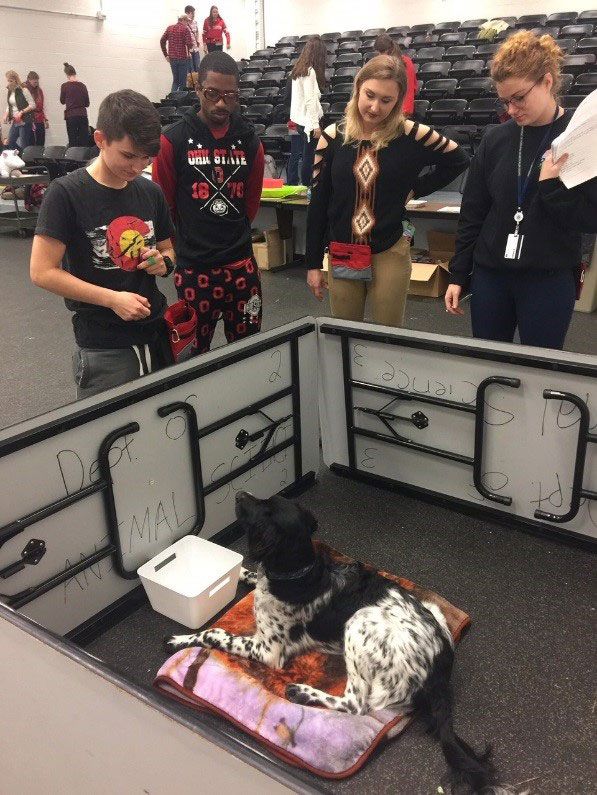Michelle Mullins and Toni Mark of the PetSafe® Training and Behavior Education Team traveled to Ohio State University to participate in a 3-week companion animal behavior section of a course offered in the Animal Sciences department. The course, called Companion Animal Biology and Behavior, focuses on educating upper-level undergraduate students on the many pieces that contribute to the overall welfare of a companion animal, including behavior.
In the first week, Michelle and Toni provided the students with the foundational concepts of behavior and learning, including the basics of operant conditioning, classical conditioning and clicker training. In a lab setting, the students then applied the lessons in an exercise with their own pet. To help the students see the power of using operant conditioning (behavior that gets rewarded gets repeated) and shaping (a training method taught with a clicker), they “magically transformed” their pets into much larger and much more difficult animals to manage and asked them to train a behavior. For example, a spaniel was “magically transformed” into a tiger that needed to learn to station himself on a mat so that the handler could provide his food safely. The group set up a training plan to slowly get the behavior, much like real tigers need to do in captivity. The steps are listed below:
- Plan to work with the “tiger” in captivity by rewarding the “tiger” from a distance and from behind a barrier
- Have the “tiger” walk towards the mat
- Place a foot on the mat
- Put two feet on the mat
- Stand all the way on the mat
- Sit on the mat
- Stay on the mat
- Stay on the mat with the presence of a food bowl being put down
- Release to eat the food
Where this lesson gets particularly tricky is that tigers need to work in protected contact! We cannot physically move our tiger, walk our tiger over with a leash, or simply tell him “go to that mat”. It required the handler to teach the “tiger” using established training plans.
 Week 2 was filled with fun as well. Michelle gave the students an in-depth look at loose-leash walking, why dogs pull and how to best train appropriate leash behaviors. She also covered no-pull solutions, including the PetSafe® Easy Walk Harness and Gentle Leader® Headcollar. The students again applied the lessons they learned in a lab setting. The students were instructed to appropriately fit these products on their pets and teach their pets how to walk nicely on a leash. This lesson was most exciting as the students who came in using pinch or prong collars were able to successfully transition to a more rewarding and effective training tool.
Week 2 was filled with fun as well. Michelle gave the students an in-depth look at loose-leash walking, why dogs pull and how to best train appropriate leash behaviors. She also covered no-pull solutions, including the PetSafe® Easy Walk Harness and Gentle Leader® Headcollar. The students again applied the lessons they learned in a lab setting. The students were instructed to appropriately fit these products on their pets and teach their pets how to walk nicely on a leash. This lesson was most exciting as the students who came in using pinch or prong collars were able to successfully transition to a more rewarding and effective training tool.
Toni wrapped up week 3 with a close look at the homeless pet population, the shelter environment and the importance of providing a training and enrichment program in a shelter or rescue. They started the week with a field trip to Columbus Humane, a local shelter. During the tour, the students carefully observed the training and enrichment programs as well as the overall stress level and stress-related behaviors that the animals exhibited. Later in the week, Toni followed up the visit with a lecture on training and enrichment programs, including how enrichment toys drastically reduce stress in the shelter, which translates to happier pets, decreased behavioral euthanasia and increased adoptions.
While at OSU, many animal clubs snagged the opportunity to meet Michelle and Toni as well. Michelle and Toni also guest lectured to the Veterinary Behavior Club, Shelter Medicine and Behavior Club, and the Animal Welfare and Behavior Club on various topics and provided them with the opportunity to evaluate case studies of companion animal behavior problems. Perhaps most exciting though, is that OSU has so many clubs that are eager to learn about the most effective training methods and how they impact the overall welfare of our four-legged pals.
It was a busy 3-week program, but Michelle and Toni are always so excited to talk the future leaders in companion animal training, behavior and welfare!


